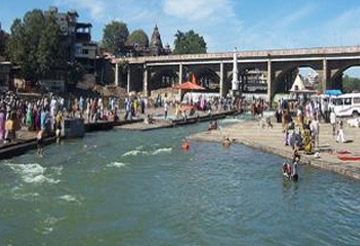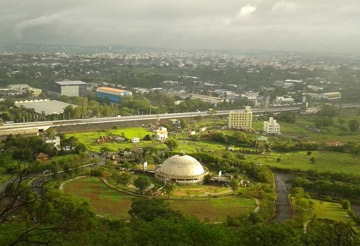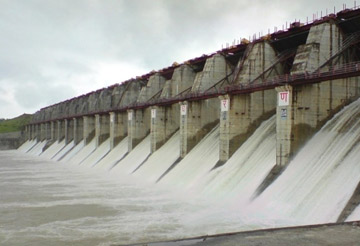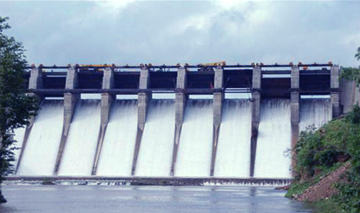Jalgaon and Aurangabad districts lie to the east of Nashik. To its south lies Ahmednagar, to its west Thane district and a part of Gujarat state, Dhule district and a part of Gujarat lie to its North. There are various types of land forms in Nashik district. In the western part of the district lie the Sahyadri mountains. Vani and Chandwad hill ranges lie in the central part, while the Kalsubai hill range is to the south. In addition, Salher-Mulher, Ramshej, Ankai-Tankai and Anjneri hills also lie in the district. In the hilly regions of the district, there are several peaks such as Hanuman, Salher, Mulher and Saptashringi. The Ghodap pass lies in the Chandwad hill range. Thalghat, Rahudbari and Bhaudbari are some of the ghats in the district.  The two main rivers in Nashik district are the Godavari and the Girna. The Darna, Godavari, Aram, Kadwa and Mosam rivers all have their source in the hilly parts of the Sahyadris and flow eastwards. Only the river Damanganga flows westwards and the Vaitarna southwards. The rivers Girna and Mosam confluence near Malegaon. Darna, Banganga and Kadwa are the tributaries of the Godavari.
The two main rivers in Nashik district are the Godavari and the Girna. The Darna, Godavari, Aram, Kadwa and Mosam rivers all have their source in the hilly parts of the Sahyadris and flow eastwards. Only the river Damanganga flows westwards and the Vaitarna southwards. The rivers Girna and Mosam confluence near Malegaon. Darna, Banganga and Kadwa are the tributaries of the Godavari.
 Nashik has a pleasant climate, warm in summer and slightly humid during the rainy season. Igatpuri, Surgana and Peth talukas in the western part of the district receive more rainfall. The rainfall decreases as we move towards the east. Winter is severe in the eastern parts of the district. Igatpuri, Saptashringi and Trimbakeshwar are cool even during summer.
Nashik has a pleasant climate, warm in summer and slightly humid during the rainy season. Igatpuri, Surgana and Peth talukas in the western part of the district receive more rainfall. The rainfall decreases as we move towards the east. Winter is severe in the eastern parts of the district. Igatpuri, Saptashringi and Trimbakeshwar are cool even during summer.
 Nashik abounds in forest wealth. The forests lie in the western part of the district. Surgana, Kalvan, Peth, Dindori, Nashik and Igatpuri talukas have a number of forests. Teak and sissoo trees are found in large numbers in these forests. Besides these, trees and shrubs like anjan, agave and bamboo are also found here. The jungles are inhabited by animals such as wolves, hyenas, sambars, foxes and birds like koels, peacocks and kingfishers.
Nashik abounds in forest wealth. The forests lie in the western part of the district. Surgana, Kalvan, Peth, Dindori, Nashik and Igatpuri talukas have a number of forests. Teak and sissoo trees are found in large numbers in these forests. Besides these, trees and shrubs like anjan, agave and bamboo are also found here. The jungles are inhabited by animals such as wolves, hyenas, sambars, foxes and birds like koels, peacocks and kingfishers.
 Nashik gets its water supply from wells, lakes, rivers and percolation tanks. The Darna, Gangapur, Chanakapur and Waghad lakes have been formed by constructing dams across rivers. gangapur-damThe Gangapur and Nandur Madhyameshwar dams have been built across the river Godavari. Similarly there are two dams across the Girna – one at Chanakapur and the other at Panzan. Sinnar, Chandawad, Yeola, Malegaon and Nandgaon talukas of the district.
Nashik gets its water supply from wells, lakes, rivers and percolation tanks. The Darna, Gangapur, Chanakapur and Waghad lakes have been formed by constructing dams across rivers. gangapur-damThe Gangapur and Nandur Madhyameshwar dams have been built across the river Godavari. Similarly there are two dams across the Girna – one at Chanakapur and the other at Panzan. Sinnar, Chandawad, Yeola, Malegaon and Nandgaon talukas of the district.
 Built on river Godavari, it is the biggest earthen dam, (13 kms. N. W. of Nashik) built in 1954. There is a garden nearby which serves as a good picnic spot, ubject to prior permission of the Chief Executive Engineer, P.W.D. Trimbak Road, Nashik. The dam is 12500 ft long, 123 ft tall and 30 ft wide. Its capacity is 7200 Million Cubic Ft and area irrigated is 64000 acres.
Built on river Godavari, it is the biggest earthen dam, (13 kms. N. W. of Nashik) built in 1954. There is a garden nearby which serves as a good picnic spot, ubject to prior permission of the Chief Executive Engineer, P.W.D. Trimbak Road, Nashik. The dam is 12500 ft long, 123 ft tall and 30 ft wide. Its capacity is 7200 Million Cubic Ft and area irrigated is 64000 acres.